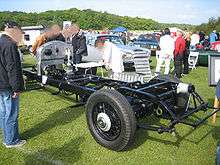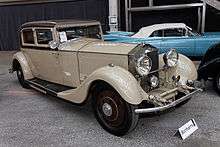Rolls-Royce Phantom II
The Rolls-Royce Phantom II was the third and last of Rolls-Royce's 40/50 hp models, replacing the New Phantom in 1929. It used an improved version of the Phantom I engine in an all-new chassis. A "Continental" version, with a short wheelbase and stiffer springs, was offered.
| Rolls-Royce Phantom II | |
|---|---|
 | |
| Overview | |
| Manufacturer | Rolls-Royce Ltd |
| Production | 1929–1936 1680 produced |
| Body and chassis | |
| Class | Luxury car |
| Powertrain | |
| Engine | 7668 cc I6 |
| Transmission | 4-speed manual |
| Dimensions | |
| Wheelbase | 144 in (3658 mm) 150 in (3810 mm) |
| Chronology | |
| Predecessor | Phantom I |
| Successor | Phantom III |

Description
Drivetrain
The Phantom II used a refinement of the Phantom I's 7.7 L (7,668 cc or 467.9 cu in) pushrod-OHV straight-6 engine[1] with a new crossflow cylinder head.[2] Unlike on previous 40/50 hp models, the engine was bolted directly to the 4-speed manual transmission.[1][3] Synchromesh was added on gears 3 and 4 in 1932 and on gear 2 in 1935.[4] Power was transmitted to the rear wheels using an open driveshaft, a hypoid bevel final drive, and Hotchkiss drive, replacing the torque tube from a remotely mounted gearbox used on earlier 40/50 hp models.[1][2][3]
Chassis

The chassis of the Phantom II was completely new. The front axle was mounted on semi-elliptical leaf springs as on earlier 40/50 hp models, but the rear axle was now also mounted on semi-elliptical springs instead of cantilever springs. This, along with the drivetrain changes, allowed the frame to be lower than before, improving the handling.[1][3] The 4-wheel servo-assisted brakes from the Phantom I were continued, and the Bijur centralized lubrication system from the Springfield-built Phantom I was included on all Phantom II chassis.[1]
The standard wheelbase of the Phantom II was 150 inches (3,800 mm). A 144 inches (3,700 mm) short-wheelbase chassis was also available.[1]
A total of 1,281 Phantom II chassis of all types were built.[5]
"Continental" model

Royce had body designer Ivan Evernden build him a one-off short-wheelbase Phantom.[1][6] Designated 26EX,[1] the car had a tuned engine,[6] five-leaf springs that were stiffer than standard[1] and a Barker four-seat lightweight close-coupled saloon body painted with an artificial pearl lacquer made from ground herring scales.[1][6] The sales department initially showed no interest in 26EX but, when Evernden returned to the office from the 1930 Biarritz Grand Concours d'Elegance, where 26EX had won the Grand Prix d'Honneur, he found that the sales department had already announced the new "Phantom II Continental Saloon", prepared a brochure for it, and costed it.[1]
According to Evernden, neither he, Royce, nor the Rolls-Royce sales department had written specifications for the "Continental" model, although he and Royce had a clear specification in mind. Based on Evernden's writings and examination of company records, historian Ray Gentile determined that the common specifications of the Continental chassis were the short wheelbase and stiffer, five-leaf springs. By this definition,[1] two hundred and eighty-one Continental Phantom II's were produced,[1][5] including 125 left-hand drive versions.[5]
Regarded as the two most important P-II Continentals are 20MS and 2SK, the only two P-II Continental Roadsters ever built. 20MS has been in a private Mid-Atlantic collection since 1989, 2SK, the Thrupp and Maberly Roadster once owned by Tyrone Power, was in the Fred Buess collection since 1958 but was sold at auction in 2010.
US-market versions
All Phantom II rolling chassis were built at Rolls-Royce's factory in Derby. The factory in Springfield, Massachusetts was closed upon ending production of the US-market Phantom I in 1931. Two US-market series, AJS and AMS, were built at Derby.[1]
It competed with the recently introduced Lincoln model K, Chrysler Imperial, Mercedes-Benz 770, Duesenberg Model J, Packard Eight, and the Cadillac Series 355.
Bodywork

Phantom II in films
When Marlene Dietrich went to the USA in 1930, the Blue Angel director Josef von Sternberg welcomed her with gifts including a green Rolls-Royce Phantom II. The car later appeared in their first US film Morocco. [7]
The Phantom II was featured in the films The Sorcerer's Apprentice and Indiana Jones and the Last Crusade.[8] When its specifications are quoted during the scene in the Kingdom of Hatay, the Sultan states that the Rolls-Royce Phantom II has a "4.3 litre, 30 horsepower, six cylinder engine, with Stromberg downdraft carburetor" and "can go from zero to 100 kilometers an hour in 12.5 seconds (and I even like the color)." However, the car used in the film was actually a Rolls-Royce Barker Saloon, with 20/25 hp.[9] It is also the star of the 1964 movie The Yellow Rolls-Royce where its engine specifications are given as the engine having a bore of 4.5" and stroke of 5.5", which would equate to 525 cubic inches
Production
- Phantom II: 1402
- Phantom II Continental: 278
References
- Brooks, Philip C. (2009). Carpenter, Rhonda (ed.). "Sir Henry's Final Masterpiece Or How Glenn Ford Pushed a Button and Won the War". The International Club for Rolls-Royce & Bentley Owners Desk Diary 2009. Tampa, FL USA: Faircount: 34–41. Retrieved 31 March 2012.
- "Phantom II". Rolls-Royce Owners' Club. Mechanicsburg PA USA: Rolls-Royce Owners' Club. 2011. Archived from the original on 2 April 2012. Retrieved 1 April 2012.
The separate gearbox torque-tube drive and cantilever rear springing gave way to the PII's integral engine-gearbox unit, Hotchkiss drive, hypoid-bevel rear axle and semi-elliptic rear springs.
- Posthumus, Cyril (1977) [1977]. The Story of Veteran & Vintage Cars. John Wood, illustrator. Feltham, Middlesex, UK: Hamlyn. p. 115. ISBN 0600391558.
This new unit gave notably better performance, delivering the customary Derby 'sufficiency' of silent horsepower via a new unit 4-speed gearbox and a hypoid bevel final drive.
- 1935 Rolls-Royce Phantom II (P2)
- Rolls Royce Enthusiasts Club B205/58
- Wood, Jonathan (2003) [1987]. The Rolls-Royce. Shire Album Series. 198 (2nd ed.). Princes Risborough, Buckinghamshire, UK: Shire Publications. p. 12. ISBN 9780747805779. Retrieved 29 March 2012.
- "THE EX-MARLENE DIETRICH, MULTIPLE BEST IN SHOW WINNING 1930 Rolls-Royce Phantom". Bonhams.
- Internet Movie Database
- 1935 Rolls-Royce 20/25 h.p. Barker Saloon as Rolls-Royce Phantom II [GPG4]
Sources
- Holmes, Mark (2007). Ultimate Convertibles: Roofless Beauty. London: Kandour. pp. 140–141. ISBN 978-1-905741-62-5.